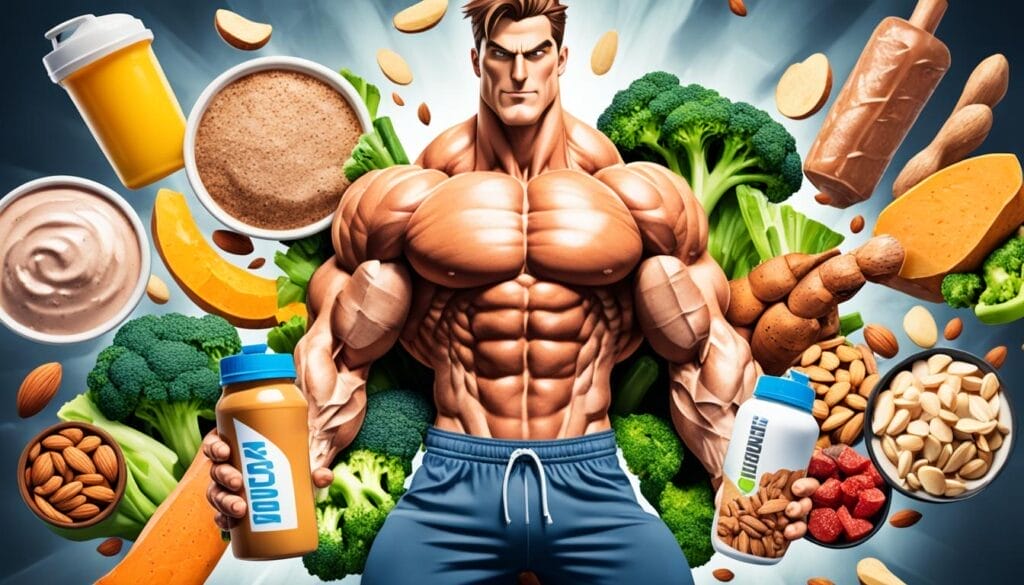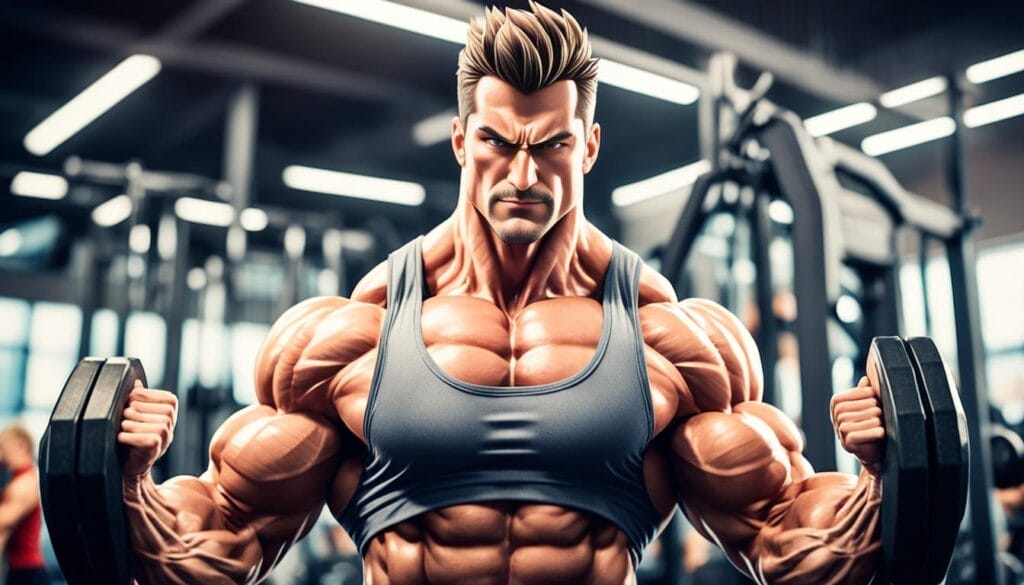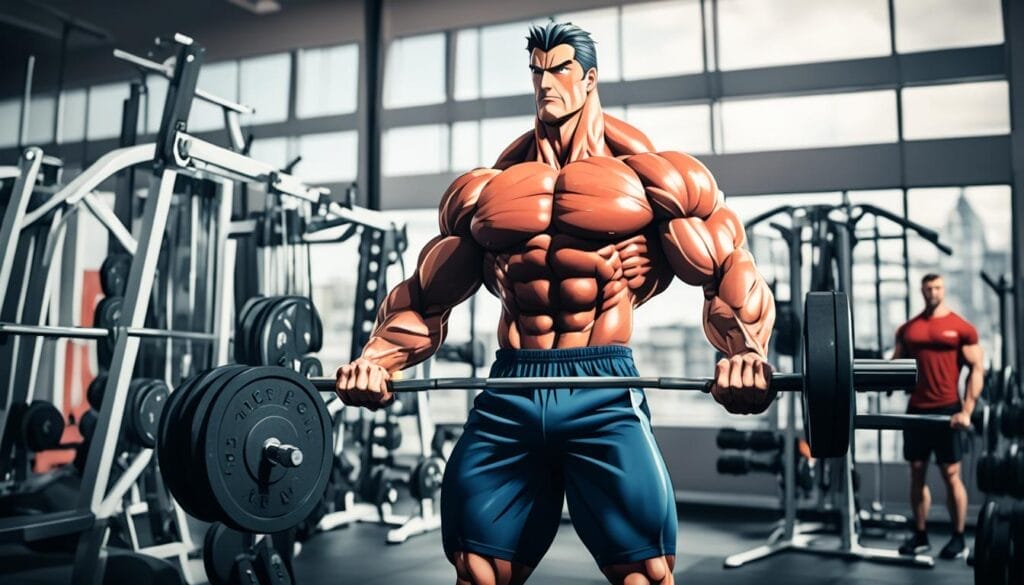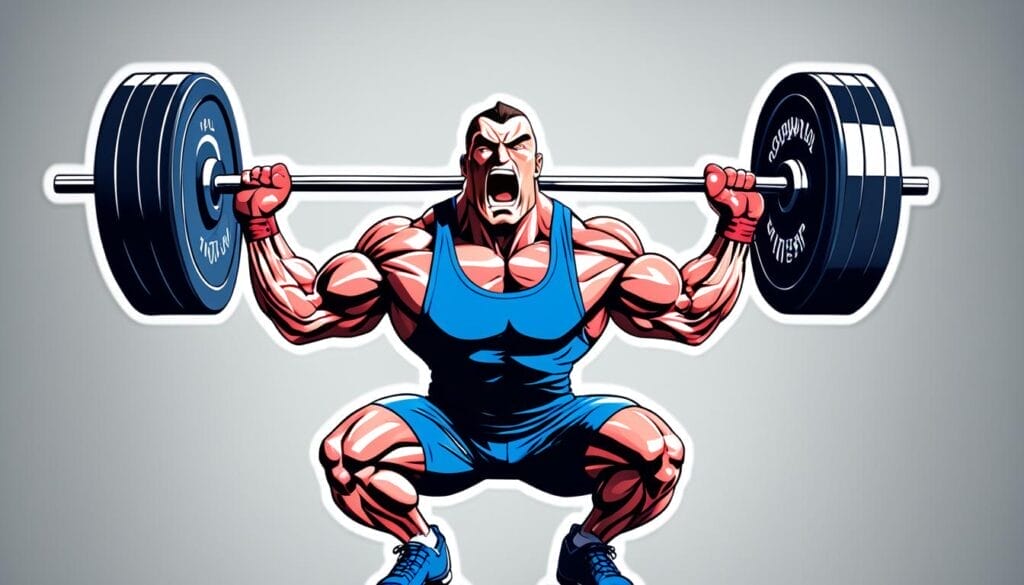Hey there! Do you want to step up your bodybuilding game? Let me share a story that will motivate you to go further and reach your true potential.
A sunny day found me at the gym, filled with the sound of weights and sights of committed people. Among them was Tom. Though Tom was a regular for months, he felt like he was not getting stronger. He finally opened up to a trainer.
The trainer showed Tom some bodybuilding techniques that were special. These were not your usual exercises. They were secret methods for building more muscle.
Tom discovered he needed to focus on the details. He had to perfect his form, technique, and even his exercises. This opened a new world of muscle-building for him.
He started using these muscle building tips in his routine. For his chest, he improved his form on the incline bench press. And for his back, each dumbbell row was done just right, working his muscles fully.
Week after week, Tom saw a big difference. His muscles were sharper, and he felt much stronger thanks to those small changes.
If you want to know more about building muscle the right way, stay tuned. We’ll talk about the best tips for upper and lower body, the importance of training hard, the benefits of muscle, and the nutrition tips essential for growth.
Key Takeaways
- Unlocking top bodybuilding techniques can take your muscle gains to new heights.
- Small adjustments to your favorite exercises can yield big results.
- Technique tips for upper body exercises include tucking elbows, leaning forward, and using an adjustable bench.
- Proper technique is essential for lower body exercises, like hip thrusts and squats.
- Building intensity gradually and incorporating rest periods is crucial for muscle gains.
Upper Body Technique Tips
To train your upper body well, you need to know when to use extra muscles and when to focus on single ones. Here are some tips for key upper body exercises:
Incline Dumbbell Bench Press
Keep your elbows tucked in while doing the incline dumbbell bench press. This targets your chest muscles and lowers the stress on your shoulders. > Stay in control and keep your movements smooth.
Shrugs
For shrugs, lean forward a little. This engages your upper back muscles better. A good lean helps lift more weight, which builds stronger and bigger muscles.
Dumbbell Row
An adjustable bench can really boost your dumbbell row technique. Placing an opposite knee and hand on it gives you a steady position. This lets you focus on your back muscles completely.
Dumbbell Pullover
Dumbbell pullovers are great for your chest and back. Make this move better by tucking your hips and stretching your lats. Move slowly and steady; don’t rush through it.
Lateral Raise
Lean a bit forward when doing lateral raises. This zeroes in on your side deltoids without overworking other muscles. Keep the speed even and don’t swing the weights.
Barbell Curl
Try pressing your pinky finger into the barbell during curls. This tricks your biceps into working harder, leading to better gains. Keep your form tight and avoid jerky movements.
Triceps Pressdown
In triceps pressdowns, let your upper arm move forward a bit. This hits your triceps more and spares your elbows from too much pressure. Remember to keep the tension up the whole time and don’t sway.
With these tips, you can make your upper body workouts count. Good form and attention to detail will help your muscles grow and get stronger.
Lower Body Technique Tips
Working out your legs needs strength and skill. Moves like hip thrusts and squats are key for leg strength and muscle. There’s no magic trick to make squats light, but you can improve leg day. And make the most of your time at the gym with these tips:
1. Hip Thrusts
When doing hip thrusts, just lower your hips till your knees go back. It makes your glutes and hamstrings work better. This way, you grow stronger and lessen the chances of a sore lower back.
2. Squats
Squats work lots of muscles and are vital for a strong lower body. For better squats, use small plates under your feet at the start. This helps your ankles move easier and improves how you squat down and stand back up.
Getting the right form and movement is key for leg exercises. Training well means you get the most out of your leg workouts. So, focus on how you move to boost those muscles.

| Exercise | Technique Tip |
|---|---|
| Hip Thrusts | Lower hips until knees track backward |
| Squats | Place small plates under feet for warm-up sets |
Training Intensity for Muscle Gains
Many think pushing to the limit every workout leads to the best muscle gains. But, high-intensity workouts can harm your body. Finding the right balance is key for progress and health.
It’s vital to increase intensity slowly over time. This way, your body adapts and becomes stronger safely. Including rest is crucial for muscle repair.
I’ve made a 7-week plan that enhances intensity step by step. This strategy aims for steady progress, avoiding overtraining. Here’s a quick overview of the plan:
Weeks 1-2: Foundation Building
Start by building a strong base in the first two weeks. Increase sets and reps slowly. Choose weights that challenge you but keep perfect form.
Weeks 3-4: Intensity Techniques
In weeks three and four, add special techniques to your routine. Drop sets and supersets can overcome muscle growth plateaus. Remember to use the right techniques to avoid injuries.
Weeks 5-6: Increased Volume and Frequency
Weeks five and six focus on increasing your workout’s load. Consider more sets and training days. This step enhances muscle-building stimuli for better results.
Week 7: Deload Week
Week seven is a deload week, reducing your training’s intensity. This allows your body to rest and recover fully. Focus on maintaining good form during this week.
After the 7-week plan, you can restart the cycle or adapt it to your needs.
Remember, high intensity isn’t the only crucial element for muscle gains. Nutrition, correct form, and rest are also vital. A holistic approach will help you achieve your body goals.
| Week | Focus |
|---|---|
| 1-2 | Foundation Building: Gradually increase sets and reps |
| 3-4 | Intensity Techniques: Incorporate drop sets, supersets, and rest-pause sets |
| 5-6 | Increased Volume and Frequency: Add extra sets and consider an additional training day |
| 7 | Deload Week: Reduce training intensity for active recovery |
Understanding Muscle Mass and its Benefits
Muscle mass is the size and weight of our muscles. It’s key for strength, balance, and more. Having more muscle can boost strength, help burn more calories, and make bones stronger. It also makes insulin work better, increases stamina, and fights off muscle loss as we get older. Working to build muscle gives a lot more than just a fit look.

Benefits of Building Muscle
Getting stronger has a lot of good impacts:
- Muscle Strength: More muscle means you’re stronger. This helps with daily tasks. With strength, you do things more easily and better.
- Metabolism: Muscle needs a lot of energy even at rest. So, more muscle boosts your metabolism. This helps burn more calories all day long.
- Bone Health: Building muscle also boosts bone health. It makes bones stronger and denser, which lowers the risk of breaks and osteoporosis.
- Insulin Sensitivity: Stronger muscles help the body use insulin better. This means it’s easier for your body to control blood sugar, lowering diabetes risk.
- Muscle Endurance: Having more muscle can boost how long you can keep going without getting tired. It’s good for physical activity without quick fatigue.
- Protection Against Age-related Muscle Loss: Ageing often means losing muscle. But building muscle fights this process, keeping muscles strong as you get older. This helps with staying active and independent.
- Mental Well-being: Exercise, especially muscle-building, releases endorphins. These are chemicals that make you feel good and reduce stress, anxiety, and depression. So, building muscle is not just good for the body but also for mental health.
How to Build Muscle Mass
To build muscle mass, you need to use a range of methods. These include strength and resistance training. Also, add high-intensity interval training to your routine to grow and sculpt your muscles.
It’s important to keep challenging your muscles over time. You do this by increasing the weight you lift or the number of reps you do. This process, called progressive overload, keeps muscle growth going.
Strength Training
Strength training, or weightlifting, is key to building muscles. You focus on exercises that work specific muscle groups with weights or machines. This includes your chest, back, legs, and arms.
Good form is crucial in strength training. It helps activate your muscles properly and prevents injury. Remember, you shouldn’t use momentum to complete your exercise.
Resistance Training
Resistance training boosts muscle growth too. It uses bands, cables, or your body weight to add resistance. This helps muscles work harder.
High-Intensity Interval Training (HIIT) also aids muscle building. In HIIT, you do intense exercise for a short time, then rest briefly. It’s known to boost muscle strength and heart health.
Training Frequency
How often you work out also matters. Muscle groups need time to rest and recover. But, you should aim for consistent training, hitting each major muscle group 2 to 3 times a week.
By using these techniques, you can make the most of your workout and get the muscle growth you want. Always remember progressive overload, proper form, and a good training schedule.
Now, let’s take a look at a table summarising the key muscle-building techniques:
| Technique | Description |
|---|---|
| Strength Training | Performing exercises that target specific muscle groups using weights or resistance machines. |
| Resistance Training | Using bands, cables, or bodyweight exercises to create resistance and challenge the muscles. |
| High-Intensity Interval Training (HIIT) | Performing short bursts of intense exercise followed by brief recovery periods. |
| Progressive Overload | Gradually increasing the demands placed on the muscles over time to stimulate growth. |
| Proper Form | Maintaining correct exercise technique to optimise muscle activation and reduce the risk of injury. |
| Training Frequency | Consistently training each major muscle group two to three times per week for optimal muscle growth. |
Building muscle mass takes time, effort, and consistency. By applying these methods and being patient, you’ll achieve the body you’re aiming for.

Nutrition and Supplementation for Muscle Gain
Eating right is key to getting the muscles you want. You need the right mix of carbs, proteins, and fats. This mix helps your muscles grow, fixes them, and makes your hormones work well.
Supplements can also give you a boost. Many people use protein powder to get extra protein easily. Creatine is another option. It can make your muscles stronger and more powerful. Adding these to your diet can improve muscle growth and how well you perform.
But remember, supplements can’t replace food. Use them with a good diet for best results. Always talk to an expert to make sure you’re using them right.
Rest and recovery are just as important as eating and supplements. Your body needs time to heal and get stronger after working out. Make sure to rest, sleep well, drink enough, and keep stress low. Doing these will help your muscles get bigger and keep you healthy.
Summary of Key Points:
- Get the right mix of carbs, proteins, and fats for energy and muscle help.
- Eat a well-balanced meal plan that supports your muscles.
- Use protein powder and creatine with your diet to boost your muscles.
- Give your body time to rest and recover for stronger muscles.
Focusing on food, supplements, and rest can really make a difference. Keep at it, be smart about your choices, and you’ll see the muscle gains you want. Consistency and good planning are your friends for a powerful physique.
Macronutrient Ratios for Muscle Gain
| Macronutrient | Recommended Ratio |
|---|---|
| Carbohydrates | 45-65% of daily calorie intake |
| Proteins | 25-35% of daily calorie intake |
| Fats | 20-35% of daily calorie intake |

Summing Up My Training And Bodybuilding Techniques
Building muscle mass is a complex process. It needs the right training, good nutrition, and plenty of rest. By using the bodybuilding techniques and advice in this article, you can reach your muscle goals.
Improvement comes slowly, so listen to your body. Work hard but look after your health too. Muscle building is more than just getting strong. It’s about a balanced and lasting fitness approach.
To get the most muscle, use good training, eat well, and rest properly. Your efforts will boost muscle strength and metabolism. They will also help your bones, insulin function, and mental health.
Start your journey to more muscle today. Use the ideas in this article. With hard work and focus, you can shape your body as you wish.
FAQ
What are some upper body technique tips for bodybuilding?
For your upper body in bodybuilding, it’s key to master certain techniques. Keep your elbows tucked in for the incline dumbbell press.
Lean forward a bit when you do shrugs. It helps. Use an adjustable bench when doing dumbbell rows. This changes the angle, working your muscles differently.
When doing dumbbell pullovers, tuck your hips. This point is often missed but aids the exercise. Leaning forward slightly boosts lateral raise effectiveness.
And, when doing barbell curls, focus on your pinky finger, enhancing your form. During triceps pressdown, allow your upper arms to move forward slightly.
What are some lower body technique tips for bodybuilding?
Getting your lower body technique right is equally crucial in bodybuilding. Especially during hip thrusts, stop lowering your hips once your knees start to bend back.
For squats, place small plates under your feet for warm-ups. Proper form and full range of motion are essential. They ensure your exercises work as effectively as possible.
How can I build training intensity for muscle gains?
Intensifying your training gradually is key for muscle gains. It’s also important to rest and recover. You can up the intensity by adding sets, using special techniques, like drop sets, or by increasing reps.
Decreasing the time you rest between sets can also boost your workout’s intensity. A structured routine, balancing high-intensity phases with recovery, is a smart approach.
What are the benefits of building muscle mass?
The benefits of building muscle are vast. They include boosting your strength and power. Growing muscles also amps up your metabolism and strengthens your bones. It improves how well your body handles insulin.
And, it increases your muscle stamina and guards against age-related muscle decline. Building muscle also enhances your mental health, which is equally important.
What are some muscle-building techniques I can use?
Muscle growth requires a good mix of exercises and training styles. Strength, resistance, and high-intensity interval training are key. Make sure to lift heavier over time – this is called progressive overload.
Doing exercises with the right form helps a lot. And how often you train matters too. Mix up your workout with various exercises to target muscle groups from different angles. This variety can help you make the most gains.
How does nutrition and supplementation contribute to muscle gain?
Nutrition and supplements play a huge role in muscle gain. It’s important to fuel your body with the right balance of carbs, proteins, and healthy fats. This is crucial for energy, muscle repair, and hormone production.
A balanced diet and meal planning ensure you get all the nutrients for muscle growth. Supplements, like protein powder and creatine, can give your muscles a boost. Remember, proper rest and recovery are just as vital for growing your muscles and staying healthy.
You can get a full range of essential vitamins and supplements at Fitness Station gym in Peterborough.





